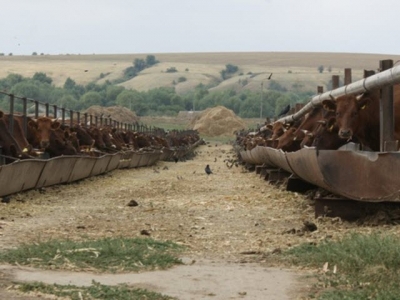Supplemented pasture systems may boost beef fatty acid range

Supplementing cattle on pasture with a lipid source may improve omega-3 and omega-6 concentrations and fatty acid composition of the beef produced, say researchers.
Photo: © GettyImages
A team of researchers from multiple academic institutions in Brazil examined the use of two lipid sources on the fatty acid profile found in the muscle tissue of beef cattle finished either in a feedlot or on pasture.
“The objective of this study was to evaluate the lipid profile of longissimus muscle and subcutaneous fat from Nellore bulls reared in two finishing systems (grazing at pasture and in feedlot) and fed different lipid sources,” the researchers said.
They found that cows finished on pasture with a supplemented diet had more saturated fatty acids (SFA), omega-3 and omega-6 levels and polyunsaturated fatty acids (PUFA) in their muscle tissue, while feedlot finished cattle had a higher omega-6: omega-3 (n6:n3) ratio than those getting a non-supplemented diet.
“Supplementing lipids to cattle finished on grazing pasture is a strategy to improve the FA composition of meat, especially to increase the amounts of PUFA and improve n6:n3 FA ratio."
1/ Why examine lipid supplementation and production methods?
Consumers have been looking for animal protein products with a smaller amount of saturated fatty acids and more PUFA, said the researchers.
One element that can alter the fatty acid profile of animal protein is the biohydrogenation process as PUFA are hydrogenated into SFA by ruminal microorganisms, they said. However, the process can vary by diet and using a protected fat (PF) or soybean grain (SG) may limit ruminal biohydrogenation of unsaturated fatty acids (UFA).
Increasing the forage to concentrate ratio adds higher concentrations of PUFA in meat, they said. And, Brazil may have an advantage as most cattle are not raised in feedlot systems for long periods of time. The country is a leading exporter of beef and works with international markets, said the researchers. However, little work has been done examining finishing on tropical pastures or feedlots on the fatty acid profiles of cows.
Most information related to the fatty acid profile of meat looks at animals raised on a concentrate-based diet in a feedlot or a temperate pasture, they said.
2/ Methods and materials
In the feeding trial, 78 young bulls were divided between two finishing systems – pasture-finishing or feedlot-finishing and given one of three diets, the researchers said. The diets included a control, and that diet supplemented with soy grain (SG) at 1% bodyweight (BW) or protected fat (PF) at 1% BW.
In the first diet, 42 animals were put on pasture and allowed 28 days to adapt and then followed for 130 days, they said. Intake estimates were made.
In the feedlot trial, 36 animals were given 28 days to adapt and then followed for 114 days, they said. The control diet for this group consisted of corn silage with a corn, soybean meal and urea concentrate.
Diet intake was measured and ingredients were analyzed, said the researchers. Animals in both groups were collected at the end of the study and carcasses were sampled for muscle tissue and subcutaneous fat to establish FA composition.
3/ Results
There was an interaction found between the lipid source and finishing system, the researchers said. This led to changes in concentration of saturated and unsaturated fatty acids.
Pasture-raised cows on the supplemented diets had more saturated fatty acids, PUFA and omega-3 levels in muscle, they said. Pasture-fed animals getting the SG supplement had the highest omega-6 levels.
Feedlot animals had the most dry matter intake, highest average daily gain along with a higher final weight, hot carcass weight and loin eye area, they said.
“Pasture-finished animals that were supplemented with PF and SG showed higher concentrations of PUFA in the muscle tissue, whereas the subcutaneous fat of animals supplemented with PF showed higher concentrations of PUFA in pasture-finished animals,” said the researchers.
The highest ratio of PUFA:SFA was found in the muscle tissue of pasture-finished animals on diets supplemented with SG, while PF supplementation raised the PUFA:SFA concentration in subcutaneous fat regardless of production system, they added.
“Animals receiving the control diet in both finishing systems had a lower n6:n3 ratio in muscle tissue,” they said. “By comparison, feedlot-finished animals showed a higher n6:n3 ratio in muscle tissue, and the highest n6:n3 ratio in subcutaneous fat was observed in pasture- and feedlot-finished animals supplemented with PF compared to the control diet.”
Animals getting the PF supplement had the lowest elongase activity and the highest atherogenicity index was found in the muscle and subcutaneous fat of feedlot-raised animals, they said.
Source: Livestock Science
Authors: G. Fiorentini, M. Santana, J. Messana, A. Valente, C. Härter, C. Rabelo, R. Barbero, D. Lanna, R. Reis, T. Berchielli
Có thể bạn quan tâm
 Benefits of fiber-degrading enzymes in dairy cow diets
Benefits of fiber-degrading enzymes in dairy cow diets The addition of enzymatic feed additives to dairy cow diets increase feed intake, animal performance
 How to keep a donkey healthy
How to keep a donkey healthy Donkeys and horses have several diseases in common, but symptoms and treatment differ, says Prof Cheryl McCrindle.
 Using ‘cow power’ to make your dairy farm self-sufficient
Using ‘cow power’ to make your dairy farm self-sufficient Manure can be used to produce biogas, electricity and fertiliser. In the process, you will recycle nutrients and increase profits while reducing pollution